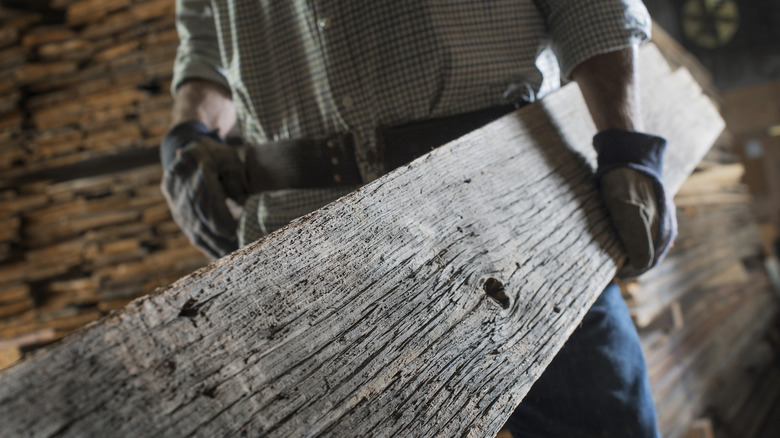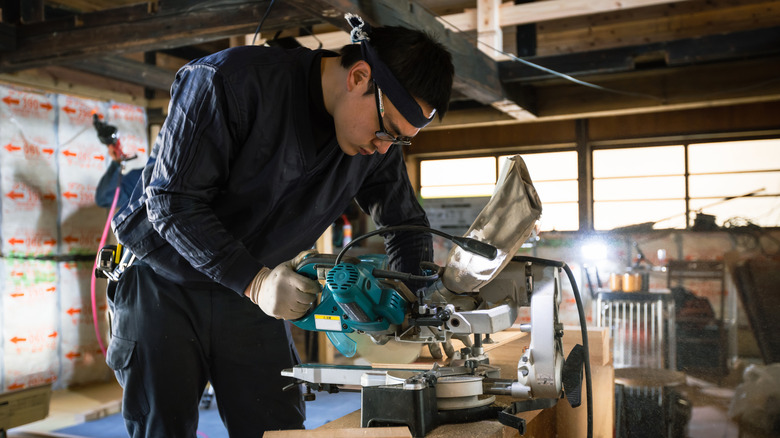Reasons Why Reclaimed Wood May Not Be Suitable For Your Home
Industrial construction accounts for over a third of worldwide energy use and CO2 emissions, and generates hundreds of millions of tons of waste in the United States alone. However, reclaiming and upcycling wood through a "circular economy" is one way to reduce that climate impact even at an individual level. Whether reclaimed lumber is used structurally or aesthetically, there are plenty of benefits when used for your epoxy dining table, the fencing around your new deck, or floorboards to replace that outdated bedroom carpet. But there are also potential downsides to decorating with reclaimed wood or using it for home projects. Namely, termites or any other pests that may have hitched a ride, and hazardous chemicals.
Reclaimed wood should be treated before reuse by fixing imperfections, removing leftover nails and paint, and drying out the lumber. Some products, like moving pallets, might be made from green or undried wood that has a greater risk of mold, staining, and decay. Hardwood used for general construction or exteriors is often just air dried, a process you can try from home if you have a month or so to let the lumber sit outside, elevated beneath cover. For manufacturing pieces like furniture, lumber typically needs to be kiln dried — which is more of a commercial process involving large-scale equipment. This process is meant to kill off pests like wood-boring beetles, a bug that hatches inside of your furniture. Termites and other wood-eating insects might not be noticed until frass appears on your floor following years of those pests compromising your home's structural integrity, at which point it may be too late.
The risks when using reclaimed wood for your home projects
Reclaimed wood carries a risk of termites. Such furniture means the chair or table could collapse underneath you, and there are similar concerns with the structure of your overall home if reclaimed wood has hidden or attracted new pests. Other signs of infestations to look out for include the lingering bodies of termite swarmers, or mud tubes running up your foundation. Infestations aren't the only reason why reclaimed wood might not be suitable for your home. Older lumber could already be growing mold or mildew, have volatile gases trapped inside, or come from a project that used lead paint which hasn't been properly removed.
The dangers of having mold growing in your walls should speak for itself, but it's still worth keeping in mind ways you can identify mold in your home and get rid of it for good. Volatile organic compounds (VOCs) are probably less of a widespread concern among the general public, but off-gassing can leech dangerous chemicals into the air for years before being noticed. The process of drying out wood can release pollutant compounds, but this isn't just an issue for reclaimed wood; even vinyl floors can damage air quality, leading to headaches or exacerbated asthma symptoms. As for leftover concerns like old nails or lead paint, just be wary of contracting diseases like tetanus from rusty metal cuts, or lead poisoning from chip flakes.
Other sustainable materials
There is still a lot of value that can be derived from properly treated, reclaimed wood products beyond the lower price point. For instance, some species of wood can no longer be harvested — such as rosewood — so recycling might be your only shot. College campuses like the University of Washington have salvaged wood programs that are worth looking into. Even if you're hesitant to lean on reclaimed wood for a home improvement project, there are plenty of unconventional building materials with less of an environmental impact and health risk. For example, bamboo, recycled plastics, and hempcrete can supplement or even replace the need for reclaimed wood in some cases.
There are other ways to make your construction projects more sustainable, too. For bigger home projects, consider firms that use just-in-time production pipelines, in which materials like lumber are purchased for that project's needs rather than seeing materials stockpiled well in advance (and potentially thrown away as a result). Further, if you want a sustainable wood material to use everywhere in your home, reclaimed or otherwise, acacia is a good option to lean on.


